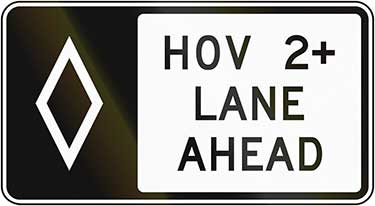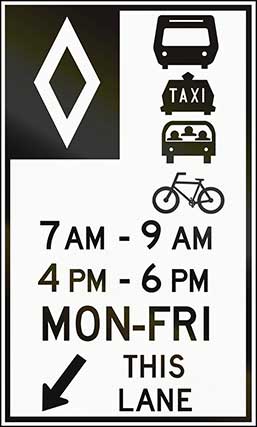
Written by Kayla Jane Barrie Updated on Mar 04, 2025 6 mins read

Have you been tempted to jump in the HOV lane? Want to beat the traffic? As more Canadians are hitting the road in personal vehicles, city planners are looking for new ways to reduce traffic congestion. This has led to the creation of HOV lanes and roundabouts. They can reduce traffic and improve environmental concerns around driving.
These lanes encourage commuters to carpool, take transit and support hybrid and electric vehicles. Lanes are open 24 hours a day, seven days a week, without any fee or permit; unless posted otherwise.
Here are the rules for using HOV lanes in Ontario.
HOV (High Occupancy Vehicle) Lanes are specially designated lanes for vehicles carrying two or more people. They are also designated for specific types of vehicles to ease highway congestion.
In Ontario, HOV lanes are identified by HOV signs and markers painted on the road. They are a diamond marker and a striped buffer to separate the lane from other lanes. You can find HOV lanes on Highway 403, 404, 410, 417, 427, and the QEW.
Vehicles can use an HOV lane if there are at least two people, including the driver. Cars, vans, light trucks, and commercial trucks (less than 6.5 meters long with a gross weight of 4,500 kg or less) can use the HOV lane.
Buses, taxis, airports, emergency vehicles, motorcycles and vehicles with Ontario green license plates (hybrid and electric) can use the HOV lane with no restrictions. All vehicles must obey the speed limit when using HOV lanes.
If you see a sign that says HOV 3+, there must be more than two passengers and a driver in the vehicle for the lane to be used.
The fine for improper use of an HOV lane is $110 and three demerit points. OPP officers enforce HOV lanes as part of their regular highway enforcement. Here are some ways you can get a traffic ticket for misuse of an HOV lane.
Hybrid vehicles and vehicles with Ontario green licence plates can use HOV lanes at all times, even if only one person is in the car. HOV lanes help reduce car emissions, improve air quality, and reduce the number of vehicles on the road. They also improve highway infrastructure by having fewer vehicles on highways. By driving a green vehicle, you are helping to minimize the impact on the environment.

The City of Toronto requires three or more passengers in the vehicle to use HOV lanes.
When the lanes were established in the early 1990s, the average of anticipated users, along with the expected operating speed of the lane and general vehicle occupancy, decided the outcome of HOV laws in Toronto. They believed having a minimum of two people would result in high levels of carpools utilizing the HOV lane, which in turn would detract from travel time incentives that HOV lanes offered.
Green vehicles are not exempt from city laws. Vehicles need to have three or more occupants. The fine for illegally driving in an HOV lane in Toronto is $110 and three demerit points.
Here are some safety tips when entering and exiting HOV lanes.
HOV lanes have led to an increase in carpooling numbers, and highway capacity has improved. They also show that travel times improve once lanes open on a highway. In Canada, there are HOV lanes in Ontario, Montreal and Vancouver. There are over 130 HOV programs in North America, totaling around 4,000 km of road. Large cities such as California and Texas have been operating with HOV lanes for 30 years.
HOT lane permits for the QEW are a pilot project to help plan for an efficient highway network across Ontario. HOT lanes allow people who drive alone to still use the lane for a small fee, unlike HOV lanes, where you need 2+ people.
You can find HOT lanes on:
The pilot will test innovative technology to support HOT lanes, tolling, compliance, and performance. Up to 1,350 permits will be sold monthly for $180 ($60 per month), and they are valid for three months. The project is ongoing.
Here are the requirements and steps necessary to apply for a HOT lane permit:
If you were not successful this round, you will need to apply again. Applications will be accepted in February, May, August, and November.
Here is a list of vehicles permitted to use HOT lanes:
Vehicles caught using the HOT lanes without a permit can be fined or issued a penalty of no less than $250 and no more than $2,500.
Whether you drive an electric car or electric truck, you can use an HOV lane in Ontario. Vehicles with a green licence plate are permitted to use the lanes at any time.
Drivers are not permitted to pass in and out of HOV lanes, even where there is a broken white line. Doing so can result in a fine or ticket, which could lead to an increase in your auto insurance quotes.
It is only legal to enter an HOV lane when overhead signs permit you to do so. The road paintings are clearly defined by white broken lines. Failure to enter when it is legal can result in a ticket.
OPP officers enforce HOV lane usage. Officers will ticket drivers who disobey the laws of the HOV lane, such as not having enough passengers, entering and exiting incorrectly, and speeding. Officers will pull vehicles over on the left shoulder. The lanes are also designed to allow enforcements to monitor HOV lane use.
Buses, taxis, airports, emergency vehicles, motorcycles and vehicles with Ontario green license plates (hybrid and electric) are all exempt from HOV lane restrictions.
You can pull a trailer in the HOV lane as long as the vehicle-trailer length is less than 6.5 meters.
Express tolls allow single-occupant vehicles to pay and use the roads. In Ontario, drivers use the 407 ETR and can obtain a transponder for secure payment. HOT lanes are also being tested for use on Ontario highways.
If HOV lanes were open to all traffic, it would reduce the effectiveness of the HOV lane. HOV lanes are designed with rideshare and transit users as a priority, with an improved and reliable trip time.
It is safer to locate a highway HOV lane to the left because it minimizes lane change interactions. Since most interchange access is located on the right side, it is safer to keep HOV lanes to the left.
There is no solid barrier to separate the lanes because it would reduce the width of highway shoulders. Reducing the width of the shoulder would make it difficult to remove snow and have a safe enforcement area. Having a painted line also allows a greater amount of entry and exit points along the highway. Drivers can respond faster to changes in traffic patterns.
When planning a trip for leisure or work, consider carpooling or taking public transit. Planning your trip ahead of time will not only be less stressful, but you can help minimize the impact of traffic congestion on the environment. By using HOV lanes correctly, you can enjoy a faster commute and avoid tickets, which can increase car insurance in Ontario.
| Categories | Auto |
|---|---|
| Tags | Driving Tips |
Checkout our latest articles on insurance and other helpful topics.
Are you wondering how much a careless driving ticket will affect your insurance in Ontario? Get our questions answered and learn how much you may see your rate go up.
Got a careless driving ticket in Ontario? Here’s everything you need to know about careless driving charges, fines, and penalties.
You may not have control over the rain, but you can control how you handle hydroplaning (aquaplaning). Here’s how hydroplaning can happen and what to do to prevent it.
Our experts offer 25 safety tips for driving in the rain. You’ll discover the best lights to use, what speed limit to follow, how to drive safe when it’s raining.